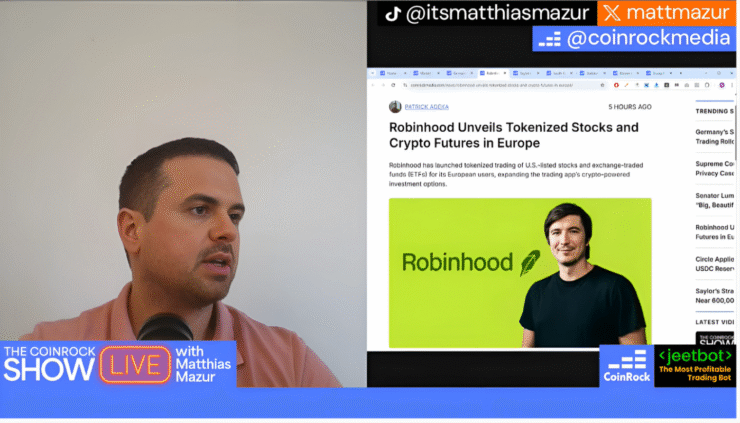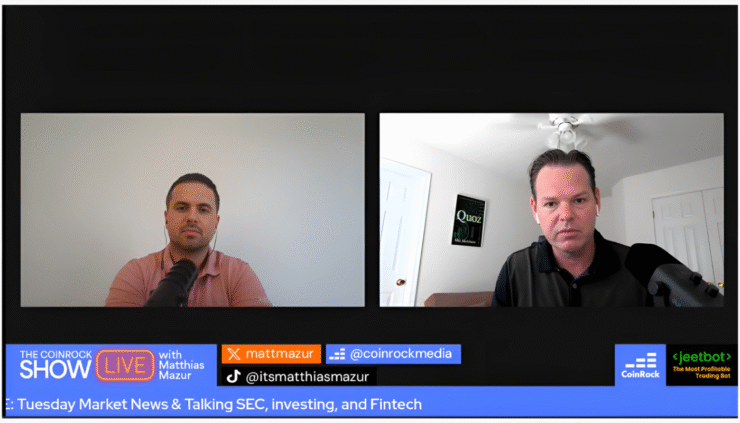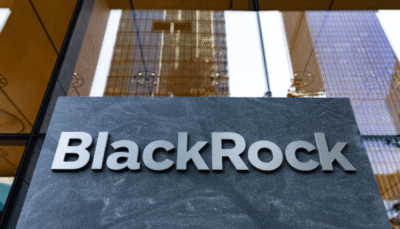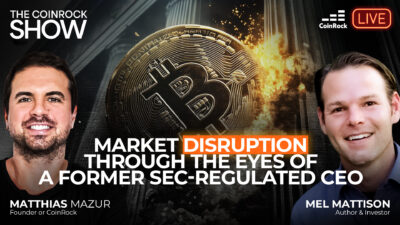This week’s episode of The CoinRock Show opened with a more casual setup than usual. With the studio mid-renovation, Matthias greeted viewers from a different backdrop, promising that the conversation ahead would be anything but ordinary.
Before welcoming the guest, he took a moment to assess the state of the market. Bitcoin has been grinding sideways near $106,000, Ethereum steady around $2,400, and retail traders have all but vanished.
“You can go to Google Trends—nobody’s searching for crypto,” he remarked, observing that despite the lack of euphoria, institutions keep buying and building.
He highlighted several headlines: Michael Saylor adding another half-billion dollars in Bitcoin, Robinhood launching tokenized U.S. stock trading, and South Korea halting its CBDC pilot. For Matthias, it was proof that while the headlines feel quiet, foundational shifts are accelerating behind the scenes.

With that backdrop set, he introduced Mel Mattison—a veteran of broker-dealer regulation and a financial thinker with a critical eye for the industry’s hidden mechanics—to explore how tokenization, stablecoins, and old-guard institutions are converging to reshape the system itself.
Introducing Mel Mattison
When Mel Mattison joined the show, Matthias opened by reading his bio—a career that spans more than two decades at the intersection of finance and regulation. Mel has served as the CEO of three SEC-regulated broker-dealers, blending insider experience with a contrarian view of how financial systems actually work. Alongside his MBA from Duke and a background in creative writing, he’s also the author of Quoz, a financial thriller exploring the consequences of quantum AI and systemic risk.
Right from the start, Mel set the tone for the conversation. He called the Robinhood announcement of tokenized U.S. stocks and private equity “seismic,” explaining,
“This is stuff people have been thinking about for years… and he’s announcing it’s available.”
For someone who has spent decades navigating the complexity of broker-dealer plumbing, it was nothing short of transformational.
“I think this is a new era of blockchain meets trad fi. It’s over—the whole debate about whether DeFi is going to enter trad fi,” he added.
This wasn’t a theoretical shift. For Mel, it was the most game-changing moment of his entire career—and he was ready to break down exactly why.
Robinhood’s Announcement Marks a Turning Point
Mel wasted no time identifying what he sees as the generational pivot in the big news of Robinhood’s rollout of tokenized U.S. stocks and private shares. For him, this wasn’t just another product launch but the formal end of the old debate about whether blockchain would ever merge with traditional finance.
“This is a Copernican break,” he explained.
“We’re moving away from an earth-centric universe to a solar-centered universe.”
Having spent decades navigating the plumbing of settlement—DTCC, Seed&Co., T+3 to T+1—Mel underscored why on-chain custody is so revolutionary. Unlike prior waves of fintech innovation, which only made transactions faster or cheaper, this fundamentally eliminates the centuries-old infrastructure that brokers, clearinghouses, and custodians rely on to create float, collateralize positions, and extract fees.
For anyone who has ever wondered why their trades take a day to settle or why intermediaries persist in a digital world, Mel’s explanation was clarifying.
“If you go to the true blockchain ownership of a security, you’re revolutionizing everything,” he said.
“This is not revolutionizing two trillion in Bitcoin. This is revolutionizing a hundred trillion in global equity.”
Asked how incumbents would respond, Mel didn’t hesitate. “They’re just going to be catching up,” he said flatly. He described Robinhood’s move as a shockwave that will force everyone—from legacy brokers to big asset managers—to rethink their business models.
Inside the Regulatory Minefield
When the conversation turned to the SEC itself, Mel offered a candid look behind the curtain. As the CEO of three separate broker-dealers, he was no stranger to the agency’s scrutiny.
“I was the face of it,” he explained.
“I would review all the paperwork, but we also used a white-shoe law firm in Manhattan—Lowenstein Sandler—the same guys who helped start Robinhood.”
He said the regulators weren’t always opposed to innovation on principle. Often, it was more about inertia, risk aversion, and the entrenched good-old-boys network protecting the status quo.
“They’re trying to stop us from doing what we want to do,” he said,
“even when it’s within the law as it’s written.”
Mel described how T+1 settlement—where brokers get 24 hours to officially transfer ownership—creates valuable float that institutions can use as collateral. Cutting that out with instant blockchain settlement would fundamentally reshape their business models and diminish their leverage.
He also addressed the common suspicion that regulatory hurdles are more about limiting opportunity than protecting retail investors.
“It’s the same thing as 1776,” he said.
“There was a good old boy club of dukes and earls, and people said, ‘There’s a better way.’”
Despite the complexity and the friction, he remained convinced that on-chain settlement is inevitable. Once the plumbing matures and liquidity fragmentation is solved, he believes it will sweep away the last barriers to 24/7 tokenized trading.
“This is starting to disintermediate real-world structures that are multi-billion, even hundred-billion-dollar industries,” Mel said.
“It’s happening whether people are ready or not.”

Monetary Illusions and the Coming Asset Boom
When asked how the next phase of on-chain trading could play out, Mel didn’t hesitate to call it a foundational shift. He believes tokenization of real-world assets—from stocks to property deeds—will define the coming years.
“I think this is the big theme that’s gonna be a multi-year theme,” he said.
He argued that while Web2 merely digitized the user experience, this is finally rewriting the financial plumbing itself. Unlike Web2, which still relied on the same old clearinghouses and settlement structures, on-chain ownership could obliterate them. “This changes the actual structure of everything,” he noted.
Mel also predicted that as traditional finance warms to crypto rails, the market will broaden beyond Bitcoin.
Even as some institutions continue to dismiss non-Bitcoin assets, he sees that skepticism fading as DeFi ecosystems start to prove their staying power.
“I used to think, if I’m gonna put money in crypto, it’s just Bitcoin,” he admitted.
“Now maybe I want to own some ETH, maybe some SOL…because there’s going to be stuff being built on this.”
The Game of Signals
As the conversation turned to Jerome Powell’s stance, Mel explained why the Fed Chair’s posture often feels disconnected from market reality. According to him, policymakers have no choice but to maintain a hard-money facade even as their actions quietly signal something else.
He described a concept called fiscal dominance—when deficits become so large that monetary policy effectively loses independence.
“There was a guy from the Fed who wrote about this,” Mel recalled.
“Part of it is…they use this term, surprise inflation. You cannot project inflation. It has to be surprise.”
If officials admitted they were monetizing debt or targeting higher inflation, markets would immediately reprice bonds and rates. That’s why Mel believes central bankers pretend to be hawkish even while loosening in practice.
“You have to act like we’re strong dollar, anti-inflation,” he said.
“And then you act differently.”.
Mel also argued the public still buys into the illusion, while sophisticated investors have started to call the bluff. “All these people are looking at it through this lens—like a Lisa Brahman on Bloomberg,” he said. “They’re scratching their heads. They’re saying, ‘Why is Bitcoin at 107? Why is the market at all-time highs?’”
The answer, he insisted, is simple:
“They’re operating from a completely wrong set of first principles.”
Question the Narrative and Watch the Tape
As the conversation wrapped up, Mel offered clear targets for Bitcoin and a final reminder to think independently. “BTC—150 is just based on monthly closings,” he explained. By measuring past cycles—“the 2021 high, 2022 low, the spread was 44K,”—he projects Bitcoin could hit $150,000 in the next six to twelve months. After that, he plans to reassess, but sees further upside possible.
Mel expects Bitcoin to be “probably the best performing asset by the end of the year,” outpacing the S&P and benefiting from the same structural forces he believes will keep lifting markets overall.
In closing, he urged listeners to be wary of the narratives pumped by mainstream media.
“Even though people sound smart—and they are smart—if they’re operating from the wrong first principles, they’re gonna be wrong,” he said.
“That’s why an idiot like me can make better calls than some of these big shots.”
His parting advice was simple: stay curious, question the prevailing consensus, and be willing to look beyond the headlines.
Where to Find Mel Mattison
X (Twitter): @MelMattison1
Website: melmattison.com
Book: Quoz: A Financial Thriller




